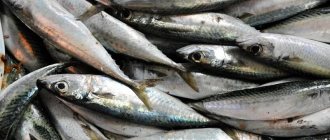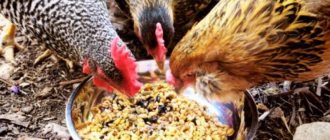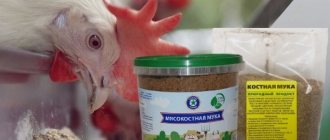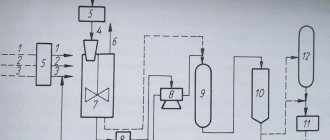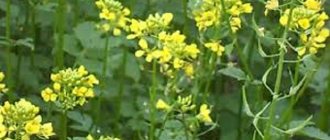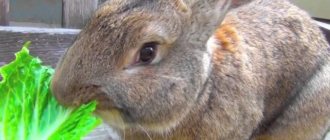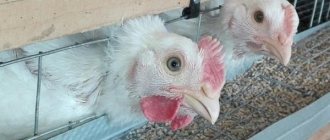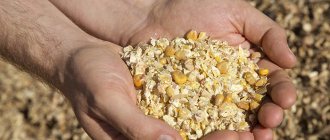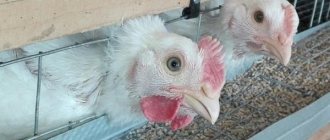2 028
no comments yet
4
Author of the article
Kiva Anatoly
Reading time: 7 minutes
With the classic feeding method, laying hens most often feed on grain; herbal supplements, vegetables and a variety of fruits are also added to their diet. When free-range, the hen's diet is more varied - green sprouts appear, as well as various types of insects and their larvae.
However, chaotic food consumption threatens to deteriorate the body’s condition and may lead to an intestinal infection. One way to avoid problems is to supply ready-made feed.
Benefits of nettle
Greens allow you not only to diversify the diet of broiler chickens, but also to save on expensive mineral and vitamin supplements.
It contains a whole complex of substances that have a positive effect on both the immune system and digestion.
Important! The younger the nettle, the more vitamins it contains. Therefore, be careful when collecting raw materials
Broiler chicken is characterized by problems with bones, since weight gain occurs several times faster than the formation of bones and tendons. Because of this, every 2-3 chickens suffer from problems with the musculoskeletal system.
The plant contains calcium, phosphorus and potassium, which strengthen the bones and also contribute to its full development.
It also contains a relatively large amount of protein, while there is practically no fat. This allows not only to saturate the chickens’ body with vitamins and minerals, but also to increase the total calorie content of the diet.
Carbohydrate feed
Carbohydrates are the main source of energy for any body. They are simply necessary for normal life. Therefore, carbohydrate feeds must be included in the diet of chickens of all types, but in different quantities.
The fact is that carbohydrates are quickly absorbed and slow down metabolism, which is why the weight of the chicken increases. This is good for broilers, but bad for laying hens, as uncontrolled weight gain will lead to obesity and reduced egg production.
All carbohydrate feed mixtures are divided into three groups.
Cereals
Grain is the most important component of the diet of all birds. Such crops are rich in minerals, so they make up at least half of the chicken’s diet.
Various grains differ in composition, set of minerals and BJU indicators, based on which they make up feed mixtures for different breeds of chickens. Depending on the age of the chicken, the size of the grain crushing changes. Chicks that are only a few days old are fed with cereal flour, older chicks are already given medium crushed grains, and adult chickens eat whole grain cereals.
What grass can you give to chickens?
The basis of the green diet is vegetable tops and weeds from the garden; they also use freshly cut grass, but in this case they monitor the presence of poisonous species found in the forbs. It is best to feed grains and legumes:
Alfalfa and clover have beneficial properties; they can be sown directly in the walking aviary as a lawn, then the birds will receive greenery from the first days of spring. Sorrel and nettle are not left out (they are scalded with boiling water); they are rich in vitamin C. Amaranth and herbs strengthen the body as a whole.
Chickens love these herbs:
Alfalfa strengthens the eyesight of birds, wheat germ improves egg production by nourishing the body with vitamin E, and yarrow and tansy are the best remedies for helminths. For good health, chickens are given quinoa, horse sorrel, pine needles, woodlice, spurge, garden crops, as well as aromatic herbs (parsley, dill, onions, beet and carrot tops).
What else can you feed chickens?
Chickens are practically omnivorous creatures, so they perfectly eat almost all leftovers from the human table, but it’s up to the poultry farmer to figure out the benefits of this or that product. Most often, birds are given the following food.
Bread
Many poultry farmers actually include this product in their chicken menu, but in reality it is not as harmless as it might seem. For example, a lot of salt and yeast are added to black bread, which can provoke fermentation in the bird’s stomach, and it is not recommended to give fresh bread at all, since when it absorbs moisture, it quickly swells and forms a dense lump in the crop that is constantly increasing in size. If the problem is not resolved in a timely manner, the bird may die.
For good egg production of chickens, the correct diet plays a very important role. Find out how much feed a laying hen should be given per day, what vitamins will help increase egg production, and whether it is possible to increase the egg production of chickens in winter.
It turns out that the best option would be to introduce “white” crackers into the diet, which are soaked in water before being directly given to the birds. Dried bread lasts longer and makes it much easier for birds to peck at the crumbs.
As for the quantity, white dried products should not take up more than 40% of the total amount of food in the birds’ diet, and black bread can be given only once a week and then in small quantities.
Important! Whatever bread you use, there should be no mold on it, otherwise it will be impossible to guarantee high egg production of chickens and their well-being.
Fish
Most chickens really like the fish, and they happily eat it in chopped form. This is a good source of calcium and phosphorus, which will be especially useful for young chickens during the period of strengthening their skeletal bones and for laying hens that are deprived of many nutrients along with the eggs they lay. You can give fish no more than several times a week, and, of course, it should not be salted or smoked foods.
To make it easier for the bird to cope with such food, it is recommended to boil it until the bones are completely softened, and then grind it until smooth and mix it with the main food. However, you should not feed your birds fish too often; 1-2 times a week using 100-150 g of product mixed with the feed mixture will be enough.
Potato
Potatoes are one of the most common foods in the diet of poultry. It goes well with a variety of types of food, quickly saturates the body of chickens and is always available for feeding. An excellent option would be to mix boiled potatoes with grain mixtures, but it is not advisable to give raw vegetables to birds in order to avoid possible solanine poisoning. This substance is collected in large quantities in the skin of potatoes and can have a detrimental effect on the digestive system of birds if the potatoes have not undergone proper heat treatment before delivery.
Important! Under no circumstances should you give birds water left after boiling young potatoes; it is in it that most of the solanine mentioned remains.
Feeding chickens with potatoes can begin as early as the third week of life, first introducing 100 g of the product into their diet, and then increasing its share to 200–300 g at one time.
Beans
Legumes (beans, beans, lentils) contain a lot of protein that is useful for chickens, as well as many important amino acids, which together determine the high nutritional value of such products. Beans will be especially useful for meat chickens, as they contribute to rapid weight gain.
Do not feed chickens from bowls or from the ground. We recommend making feeders for poultry: a hopper feeder, an automatic feeder, or a feeder made of PVC pipes.
For better absorption by the poultry stomach, before distribution, all varieties must undergo heat treatment (they are boiled on the stove for 30–40 minutes), with preliminary soaking. Starting from 4 weeks of age, the share of broad beans in the diet of young animals can be no more than 5%, and with age this value increases to 8–17%, giving beans no more than once a week.
Peas
Like other legumes, peas are an excellent source of protein and are well suited to somehow diversify a chicken's usual menu. As in other cases, they begin to introduce it into the diet in small portions and only in boiled form. With age, boiled food can gradually be replaced with dry, chopped peas, adding it to other foods.
If you believe the reviews, then peas help increase egg production. On average, it is enough to give it to the bird once every 7 days in the amount of 200–300 g, divided into several doses.
Did you know? Properly dried peas can be stored for 10–12 years without losing their nutritional properties.
How to steam feed for chickens
Farming is becoming more popular and more profitable. Owners of private houses, estates and summer cottages most often give preference to chickens.
In order for chicken breeding to be profitable, they need to be well and properly fed, so the bird’s diet must contain not only grass, but also mixed feed. Compound feed will be useful provided that you steam it correctly. Let us dwell on the nuances of this procedure. The most important thing is to use water at a certain temperature for steaming. It should not be more than fifty degrees. At high temperatures, compound feed becomes absolutely useless food, since all active substances in it are destroyed. Use only the amount of water recommended by the manufacturer. Many farmers claim that it is not necessary to steam feed, but birds are reluctant to eat it when it is dry.
Before steaming, you can add grass, carrots, herbs and any other vegetables to the feed. Then add a small amount of water; you can use milk or even whey as a liquid. After this, the feed must be mixed well to obtain a more or less homogeneous mixture, and immediately given to the birds. Remember that steamed feed should be in the feeder for no more than twenty to thirty minutes, especially in hot weather, as it quickly deteriorates and sours.
Mealworms
Perhaps this is the most favorite of all delicacies for chickens! Mealworms are highly nutritious and contain over 50% pure protein.
For him they are ready to fight tooth and nail. Chickens will drop everything they are doing and come running from any corner of the garden, just so as not to miss such a pleasure.
For one chicken, 5-10 worms (or 1-2 teaspoons by volume) will be enough. They should not be given more regularly as too much protein can be bad for their kidneys.
Purchasing mealworms specifically on a regular basis can be expensive. Next time we will try to tell you how you can make your own farm for breeding mealworms and please not only your laying hens, and maybe even sell extra batches.
How to prepare feed for laying hens?
At home, of course, it is best to prepare feed for laying hens with your own hands. It is both cheaper and easier to maintain. All food is divided into two groups: soft and hard. We consider all grain mixtures to be solid. They are prepared taking into account the number of birds for each day. To do this, various types of grain and seeds are purchased and mixed according to standards.
We include all vegetables, root vegetables, steamed grains and bran, chopped greens with the addition of flour as wet food. All this is easy to prepare with your own hands. For example, for daily feeding, you can grate vegetables or boil potatoes, add finely chopped herbs, steamed bran and season everything with cake. From grain or bone meal you can make a mash containing whey.
Here are some more tips on how to properly prepare chicken food:
- potatoes and peelings need to be boiled and mashed;
- all vegetables are grated on a coarse grater;
- The bird eats shell rock and mineral feed crushed;
- fish and meat waste, as well as from the table, cannot be fed raw;
- Young animals eat grain in flattened and ground form;
- In winter, grains can be sprouted, increasing their value and nutritional value with your own hands;
- soak the legumes and boil the beans;
- In order for chickens to lay eggs, you can use yeast - correctly 5-10 grams of yeast per 1 kg of feed.
Feeding standards for laying hens
Almost omnivorous chickens can search for food almost constantly, but excess nutrition does not have the best effect on the well-being of the bird and the number of eggs it lays.
Therefore, giving chickens a strictly defined amount of feed and following a feeding schedule is very important.
An approximate daily diet for laying hens of egg lines should consist of the following components:
- cereal grains - 45 g (in winter - 55 g);
- mealy feed - 20 g;
- pulses - 5 g;
- animal feed - 5 g;
- meal, cake, yeast - 7 g (in winter - 6 g);
- greens, root tubers - 55 g (in winter - 20 g);
- grass, hay, pine flour - 5 g (in winter).
For laying hens of meat lines, the composition of the approximate daily ration does not differ, but the amount of some components increases:
- cereal grains - 50 g (in winter - 60 g);
- mealy food - 25 g (in winter - 20 g);
- grain legumes - 5 g (in winter - 6 g);
- animal feed - 6 g;
- meal, cake, yeast - 8 g (in winter - 7 g);
- greens, root and tuber crops - 60 g (in winter - 20 g);
- grass, hay, pine flour - 10 g (in winter).
Based on the weight of the bird, you can calculate the amount of feed that needs to be given to it. This is done on the basis that with an egg production of 100 eggs and a laying hen weighing 1800 g, the amount of feed should be 125 grams.
It should be divided in equal parts by the number of meals per day. For every additional 100 grams of weight, 5 grams of feed should be added to the daily diet.
For a chicken that produces 130 eggs, you need to increase the daily amount of feed by 5 grams from the norm. For a laying hen producing 160 eggs per year, you need to add 10 grams of feed.
The feeding regime for laying hens can be varied by the poultry farmer himself, focusing on the well-being of the chickens, breed characteristics, and the nuances of keeping them. On average, to maintain the productivity of laying hens, poultry feed is given 2-3 times a day.
Diet and norms
The diet for laying hens at home also provides for a clear feeding regime and standards.
How much feed does one laying hen need per day?
The average daily requirement for laying hens of the required feed is: from 120 to 130 g of food.
But don’t forget that air temperature directly affects how much the chicken eats. If in summer the temperature begins to exceed the norm for chickens by 1 degree, they eat 1% less. In winter it’s the other way around. Therefore, in the summer, you can include less feed in the daily diet, but use varieties that contain more nutrients, based on how much feed the chicken eats.
Some farmers, in order to find out how much feed a bird needs, practice calculating the average daily requirement depending on its weight. For a bird weighing from 1.5 to 1.8 kg, the feed consumption will be about 120-125 g, and for a two-kilogram laying hen the daily ration requires 130 g.
How many times should chickens be fed during the day?
How many times to feed chickens depends on the time of year: in summer - twice, in winter - three times a day.
The feeder is filled only 1/3 with dry mixtures - as much as the chickens eat, so that less feed is raked by the birds. The mash is applied in such volumes that the chickens can consume it within an hour before it turns sour. Be sure to ensure that the food is supplied with sufficient amounts of clean water in the drinking bowls.
They provide wet food in the morning and lunchtime, and grain for laying hens in the evening. Mash in the evening is contraindicated. The evening feed should be light, so it is recommended to feed the bird grain at night. You need to clean the feeders as many times as you change the food per day.
In winter, the feeding schedule is as follows: morning feeding at 08.00, lunch feeding at about 13.00, and evening feeding at 18.00. In summer, laying hens are fed twice, if there is the possibility of walking and grazing on green grass. In this case, the feeders are filled at 08.00 and around 18.00. In the morning the diet consists of mash, and in the evening - of dry grain feed. If the chickens are kept in cages and not grazed, then leaner feeding should be provided in the summer. These factors determine how many times a day and how often to feed your pets.
What to feed birds for high egg production?
If in summer vitamins are abundant due to the riot of greenery and herbs that the birds eat, then in winter you need to carefully select the diet for feeding laying hens to maintain egg production. Let's determine what to feed the chickens so that they can lay eggs better in the cold. The sources of vitamins in this case are juicy vegetables and root vegetables, sprouted grains, cakes and flour substances, hay and silage, as well as dairy products in large quantities - about 100 g per day. The mash can even be prepared using fish broth.
During the molting period, there are also special requirements for what to feed laying hens. It is necessary to increase the content of juicy and protein (in particular animal origin) food. The feeding itself should not be as plentiful as at the peak of egg laying, but varied. At this time, the bird should be provided with such food components as shells, carrots, pumpkin, potatoes, cabbage, chalk, slaked lime, and baker's yeast. Vitamin supplements are also introduced into the diet.
Feed composition
Combined mixtures are often used to feed laying hens.
They have all the important substances that these birds need. But what is branded compound feed made from? Formulations may vary in ingredients and quantity, but the main components are usually the same. Feed for chickens
- The following are usually used in chicken feed: corn, wheat, sunflower meal, bone or fish meal, salt, chalk, food phosphate.
- For the feed that is fed to young animals, the following is taken: corn, wheat, barley, cake, phosphate, chalk, wheat bran, meat or fish meal, salt.
- Compound feed for adult laying hens includes: corn, barley, wheat, soybean or sunflower cake, fish or bone meal, phosphate, salt, crushed shell rock.
Important!
Compound feed is a dry type of feed. If this is what chickens are given on a regular basis, it is important to provide the birds with access to clean, fresh water.
When choosing feed for laying hens, certain points are taken into account.
- Composition of feed. It is important to study it before purchasing. Not all manufacturers care about the quality of the product, so it is better to check what the feed is made of.
- Purpose. Depending on the type of feed, it can be intended for chickens, young animals, and adults. In addition, such food can be used for various purposes: increasing productivity, immunity, increasing egg fertilization, etc.
- Granulated food stimulates the gastrointestinal tract and is recommended for birds that are active. The crumbly mixture is more suitable for chickens and young animals that are kept without walking.
Granular feed stimulates the gastrointestinal tract and is recommended for chickens that are active
If there is no suitable feed for sale, the price is too high, or there are doubts about its quality, you can make feed for chickens with your own hands. To do this, you can use one of the three recipes presented below.
The first feed recipe contains the simplest ingredients. First you need to prepare them all, measure them and only then mix them.
- Corn – 45%;
- wheat – 12%;
- barley – 12%;
- peas – 7%;
- sunflower meal – 7%;
- meat or fish meal – 6%;
- herbal flour – 2%;
- chalk – 2%;
- salt – 0.3%;
- soda – 0.1%.
Important!
Before using grain for feed, you must first sift it to get rid of dirt and then crush it.
The crumbly mixture is more suitable for chickens and young animals that are kept without walking
The second recipe contains many more ingredients, but is also more nutritious. For this food you will need the following ingredients:
- wheat – 55%;
- barley – 30%;
- sunflower cake – 10%;
- wheat bran – 5%;
- crushed shell – 5%;
- meat and bone meal – 4%;
- vegetable oil – 2%;
- chalk – 2.6%;
- salt – 0.3%;
- premix – 0.1%.
In winter, the feed consumption rate increases
The third recipe for home-mixed feed contains a lot of wheat. It is also nutritious and does not have a negative effect on the weight of birds. So, for this mixture you will need:
- wheat – 64.2%;
- sunflower meal – 17.5%;
- chalk – 7.5%;
- meat and bone meal – 4%;
- vegetable oil – 2.5%;
- yeast – 2.5%;
- premix – 1%;
- soda – 0.7%;
- salt – 0.1%.
Types of feed
To make homemade feed, first mix the dry ingredients, then add chalk, salt, soda and other additives, which are contained in small quantities. Ready-made, loose food can already be given to the bird, but if you need to make granules, then first a little water is poured into the mixture to make a tight dough, then the mixture is poured into an extruder (granulator) and the resulting granules are dried.
The amount of feed required by laying hens per day is usually indicated on the packaging. Essentially, these birds eat as much as they need to replenish their strength. For an adult, approximately 120 g of feed per day is enough, but these are approximate norms that differ depending on the characteristics of the bird and the type of mixture.
It should also be taken into account that if the feed contains many energetically valuable components, then its norm per day decreases, but if there are few such components, then the norm increases. The season also plays a significant role in the amount of feed consumption.
- In the summer, laying hens eat a little feed, because it is warm outside - the body's energy consumption is at a normal level, and there is a lot of tasty pasture on the run.
- In winter, birds spend a lot of energy on heating their bodies, and there is no walking as such at this time, so the rate of feed consumption increases.
Do not forget that any changes in the diet of laying hens are carried out gradually. When introducing a new feed, it is necessary to monitor the reaction of the chickens’ body to it. If they do not tolerate the new food well, then it is advisable to return them to their previous diet or develop a different diet.
Depending on the type of your farm, the type and composition of feed is selected. For the meat sector, protein feeds are required, which contain easily digestible proteins, fiber and mineral and vitamin supplements. For the greasy area, roughage and energy feeds, based on complex carbohydrates, are most suitable. In general, compound feed has a composition approved by GOST. According to the standard, food must meet several basic characteristics:
- nutritional value (fiber and protein content);
- mineral supplements, the main ones of which are potassium, sodium and phosphorus;
- correct grinding;
- correspondence of pellet size to age groups of pigs.
Find out about building a pigsty for piglets here.
Feed composition
You can prepare compound feed with your own hands; this will greatly reduce your feeding costs. Also, the food you prepare will have exactly the composition that you need. There are many recipes, all of them are suitable for milking different age groups of pigs. The cooking technology is universal:
- Wash and dry all grain/legume components.
- Grind them using a crusher.
- Add all required additives and components.
- Add water to obtain a dough-like mass.
- Pass the resulting mixture through a meat grinder (this will form granules similar to factory ones).
- Dry the granules and they are ready for use.
Adults
Adult pigs need food that stimulates weight gain. Their body is already ready to digest any type of feed, so no special preparation is required. The best recipe for increasing weight at slaughter is the following:
- 700 grams of barley and oats;
- 60 grams of sunflower meal;
- 150 grams of herbal flour;
- 60 grams of feed yeast;
- a tablespoon of crushed chalk;
- a spoonful of table salt;
- spoon of premix.
We suggest you familiarize yourself with: Compound feed for fish || Feed for fish
This feed will provide the pig with a complete set of proteins, minerals, complex carbohydrates and vegetable fats. To ensure that the animal does not get used to the same diet (this leads to a decrease in the absorption of nutrients), this composition must be alternated with others. Good alternative:
- 250 g wheat;
- 150 g barley;
- 100 g oats;
- 350 g bran;
- 100 g animal BMK;
- 20 g lime flour;
- 5 g premix;
- 5 g salt.
For piglets
The piglet’s body is not ready to process coarse or coarsely ground feed, and also does not digest heavy protein products well. Compound feed for babies should begin to be introduced 4-5 days after birth, along with the sow's breast milk or formula (if the pig does not breastfeed the offspring). The composition for piglets is as follows:
- powdered milk (the basis of feed);
- barley flour (40% of the total amount of feed);
- fish flour;
- feed yeast (no more than 1.5% of the total mass of the mixture);
- grass meal;
- premix;
- legume flour;
- calcium carbonate.
You can read what to feed piglets at this link.
For sows
Compound feed for sows is not much different in composition from conventional mixtures for adults. Many farmers do not make a fundamental distinction and use the same feed. The only thing you should do is to reduce the amount of legume additives. The best option:
- 400 grams of oats;
- 400 grams of barley;
- 160 grams of alfalfa flour;
- 120 grams of meat and bone meal;
- 80 grams of sunflower cake;
- a tablespoon of table salt;
- 20 grams of chalk.
Feed for pigs is not only the main part of their diet, but also the main cost of maintaining these animals. Therefore, it is very important not only to make it correctly with your own hands, but also to choose it correctly. The successful growth and development of pigs, as well as the correct expenditure of funds, depend on this.
Pigs are those animals, the main part of the expenses for their maintenance is on feed. In order to raise healthy, strong and heavy piglets, you need to put in a lot of effort, and using ready-made feed simplifies this process.
It is important to understand that for pigs of different age groups the composition of ready-made feed differs significantly. For example, for small piglets it is easier in terms of impact on the digestive system, but for queens, on the contrary, it is fatty and high-calorie.
The main feature of this mixture for feeding pigs is that it is completely ready for use.
Its composition is balanced, and the manufacturer additionally indicates the volume of the mixture that must be given to each animal daily, depending on its age.
We provide the birds with the necessary amount of water
The vital activity and vitality of the chickens’ body is simply impossible without a sufficient amount of water.
Water is another, almost the most important, component of the diet of any bird species.
Thus, the body of one individual consists of 70% water. If at least 25% of its interest is lost, then the bird may simply die. If within 2 days the hen does not have the opportunity to drink water, then she will immediately stop laying eggs, and if she continues in a pitiful state for another 5 or 8 days, she is guaranteed to die.
Therefore, birds need to be given water daily, just like the other foods listed above.
It is important that the water is not too warm, not too cold
Its optimal temperature is from +10 to +15ºС. How much water birds need will depend on the air temperature - the hotter it is, the more water they need. If at a temperature from +12 to +18 ºС one individual is able to drink approximately 250 milliliters, then when the thermometer increases above +35 ºС the same individual will need about 350 milliliters.
565
I've already helped
Chickens are not very demanding birds when it comes to feeding. Every owner is interested in ensuring that the birds grow healthy and resistant to diseases and climate changes and do not reduce egg production at any time of the year.
Therefore, in addition to grain crops and a variety of mixed feeds, chickens should have greens in their diet. In the summer, they themselves will find foods rich in proteins and vitamins in the ground. In the autumn-winter season, it is necessary to add green mass to the main diet.
The most suitable product, rich not only in vitamins, but also in proteins, carbohydrates and a whole range of macro- and microelements, so necessary for both adult laying hens and chickens, is common nettle, which grows everywhere. Therefore, in order to provide balanced nutrition to feathered pets, it is necessary to timely prepare nettles for the winter for chickens.
How to give nettles to chickens
Diet of laying hens depending on the age of the bird
Feeding the bird a certain set of products is required based on its age. This is due to intensive egg laying. It is known that the most productive period for laying hens is the first year of their egg production with a peak at 27 and 28 weeks. It is important to feed your chickens generously during this time.
During the period of high egg production, the bird's daily diet includes carrots, boiled potatoes, barley, pumpkin, yeast, fish (bone) meal, crushed shells, millet, and green grass. This food allows the chickens to receive many nutrients. It is also recommended to gradually introduce protein into chicken feed to improve egg quality. This must be done when approaching the peak of egg production.
When a hen reaches the age of 1 year, egg production rates decrease significantly, so the hen no longer needs energy in the same quantities. During this period, you can feed laying hens with the same ingredients, but only fishmeal can be replaced with pumpkin and barley.
So, for one laying hen aged from 6 to 12 months there is the following amount of ingredients:
- baker's yeast – 1 g;
- meat and fish waste – 5 g;
- fish meal – 4 g;
- boiled potatoes – 50 g;
- pumpkin – 0;
- carrots – 10 g;
- crushed shell – 5 g;
- feed chalk – 3 g;
- green grass – 30g;
- sunflower meal – 11 g;
- corn – 40 g;
- barley – 0;
- wheat – 20 g.
For one hen over 12 months old there are the following amount of ingredients:
- baker's yeast – 14 g;
- meat and fish waste – 10 g;
- fishmeal – 0;
- boiled potatoes – 50 g;
- pumpkin – 20 g;
- carrots – 0;
- crushed shell – 5 g;
- feed chalk – 3 g;
- green grass – 30 g;
- sunflower meal – 14 g;
- corn – 0;
- barley – 30 g;
- wheat – 40 g.
With proper feeding of laying hens at different stages of maturation, it will be possible to obtain high-quality, large eggs in the future.
What grass should you not give to chickens?
Of course, not all greens are allowed for chickens to eat. There are varieties of plants that can seriously harm laying hens due to the toxic substances in their composition. Therefore, it is prohibited to give such herbs. The key to keeping chickens healthy will once again be the careful attention of the farmer. He needs to clearly know the list of herbs that are not suitable for adding to the feeder.
Feeding which greens will jeopardize the well-being of chickens? These are burdock, dandelion, celandine, juniper, etc. As a rule, these are the plants that can grow on the site. Among the things that fill the garden there are also harmful products. What herbs are these? These include:
- dill leaves;
- green part of tomatoes;
- potato inflorescences and leaves;
- beet tops.
Wormwood is given with caution. Sometimes it can cause diarrhea and diarrhea in birds, so it is better for the breeder to avoid it.
Rhubarb contains a lot of acid, which can also be harmful. Therefore, the inclusion of this herb in the diet is also approached carefully.
In the process of evolution, domestic chickens have acquired the ability to independently determine which plants they should refuse. For example, they avoid celandine. But don't rely solely on their legibility. Spend the extra time creating a balanced diet to ensure your chickens are fed only healthy foods.
This is done in order to avoid unnecessary problems that may arise due to harmful products. The food listed above, including tomato greens, should under no circumstances end up in the hen's feeder; this must be strictly controlled.
What's prohibited?
Chickens are omnivorous birds that feed on pasture, but they are not allowed to eat everything. For example, it is highly undesirable to feed birds fish oil, as it causes the eggs to smell unpleasant. You should not give chickens hard food - potato peels, watermelons, oranges. It is difficult for chickens to digest this food, and this threatens the development of encephalopathy.
Overfeeding chickens can cause diarrhea and indigestion. If this happens, it is necessary to stop feeding the birds vegetables for a while.
It is useful for chickens to include boiled potatoes, mashed and included in the mash, in their diet. You should not give the bird more than 50 g per day. Sprouted or green potatoes are considered more dangerous; they contain solanine, which is harmful to the body.
It is also recommended to include zucchini in the mash, especially in winter, as they are an excellent substitute for green grass feed. But there is also a negative point: you need to avoid feeding the bird zucchini as a monofeed; they are also not suitable for birds under 3 weeks of age. Overfeeding this vegetable can cause diarrhea and digestive disorders.
Before you start breeding chickens that should produce a good amount of eggs, you need to know what to feed them and how to structure their diet in such a way as to increase egg production. This way you will be able to make a good profit and provide your family with high-quality large eggs all year round.
0
0
Copy link
What should the diet consist of?
The nutrition of laying hens should be based on the natural needs of poultry. Under natural conditions, chickens look for grains, eat various herbs, seeds, leaves of bushes, vegetables, berries, as well as worms, larvae and even small reptiles. Of course, at home, the composition of the food is extremely different, but it must be balanced and varied.
Feeding domestic chickens is based on grain; it should be at least 60% of it in the diet. You can give it either whole or crushed, adding it to mash. In addition, poultry should receive vitamins from greens and vegetables, mineral supplements from various premixes and animal feed. Let's take a closer look at what a proper diet should consist of and what food should be for laying hens.
Corn
Since chickens have a short digestive tract and an active metabolism, grain is the most suitable feed for proper care. But we must not forget that grain contains little protein, so it must be combined with proteins. In addition, not every grain is suitable and not all have the same effect on the body. For example, in summer, millet, barley and oats are more suitable; they are given so that chickens lay eggs well. But in winter it is better to feed buckwheat, wheat and corn, as they increase fat and energy.
In addition to corn, other grains should be included in the bird’s diet:
- sunflower and flax seeds - increase the excitability of the bird, allowing it to lay eggs well;
- barley – produces tasty and juicy meat, more suitable for meat chickens;
- millet – contains a lot of fiber, millet is recommended for young animals;
- wheat is an excellent source of vitamins B and E (especially healthy wheat bran);
- oats are a valuable but poorly digestible feed for chickens; they provide no more than 20% of the total grain requirement per day (oat bran is also suitable);
- buckwheat - close to oats, but in excess is harmful to birds, so you need to give no more than 10% of the norm per day;
- legumes - give so that chickens lay eggs well;
- cakes and meals are complete supplements rich in protein and protein.
Green feed
This, of course, is a source of vitamins and minerals; out of the total amount of concentrates per day, you should add about 20%. The bird itself eats greens to its heart's content while walking. In non-walking conditions, you need to give clover, alfalfa, and young meadow grass. Dill and young peas can be good garden herbs. Among wild plants, nettle occupies a special place - a valuable source of vitamins A, C, K, B.
A good green food for laying hens, especially in winter, is pine needles. Spruce and pine branches contain a lot of vitamin C and carotene. They increase the appetite of chickens and are good for digestion. In summer they are also given to help laying hens lay eggs. Although the chicken is not an animal, it eats hay well in winter.
Roots
If you have a vegetable garden, of course, your chickens will have root vegetables in their diet. The laying hen eats grated turnips, pumpkin, beets, and carrots. These vegetables are useful for both young and adult birds. Moreover, carrots are given as a substitute for fish oil and to help laying hens lay eggs well. From the norm, you can eat 20-30 grams per head raw and 6-8 grams dried.
Also, of all garden root vegetables, chicken willingly eats potatoes. Peelings or small red mullets are boiled well and added to the mash. Give at the rate of up to 100 grams per day. It is better to give greens and vegetables mixed with bran, as well as slightly boiled. This is especially true for table scraps and kitchen scraps.
Animal feed
This feed for laying hens, rich in amino acids, affects productivity and growth.
- Dairy products are good for chickens. Give the bird kefir, cottage cheese, whey instead of water.
- Meat and bone meal is a source of minerals and is added to mash.
- Meat and waste - given in boiled and chopped form, increases the development of young animals, and is given so that chickens lay eggs well.
- Fish meal and fish - saturates the body with phosphorus and calcium.
- Earthworms are a protein supplement, especially good in winter.
- Bones - when crushed, give the bird health and fertility, and help it lay eggs well.
Mineral supplements
Such feed for laying hens is simply necessary, because often the composition of ordinary food is poor in special valuable substances. This group includes chalk, salt, limestone, shell rock, ash, and gravel. If a bird walks and has free grazing, it finds pebbles for itself and eats them. If she is in a closed enclosure, then you need to pour shell rock into a separate container, chalk, salt, and also add piles of ash and sand. In addition, pebbles and shell rock help digest food well.
Features of the selection and preparation of feed
In order to choose the right feed, you need to start from the breed of chickens kept on your farm. Different breeds need different types or in different proportions. The age of the birds must also be taken into account. So, feed for adult chickens is not suitable for young animals.
If you choose ready-made feed, you need to pay attention to the manufacturer. High-quality feed can only be produced using good equipment. The trusted manufacturer has fairly high quality standards.
The feed should contain vitamins, minerals and other useful additives. You should not buy food with enzymes, antioxidants, antibiotics, or dyes.
As for making feed yourself, you need to know how to prepare it and purchase the necessary high-quality ingredients. Cereals and legumes must look good and not smell moldy or damp. Vitamin supplements and flour must meet quality standards.
It is better to buy such ingredients in a store rather than at the market. In the latter case, there is a possibility of infection.
It is impossible to say for sure which feed is better: store-bought or home-made. The first is scientifically developed taking into account the needs of birds of any age and breed. It is already prepared, you just need to pour it in - no need to waste time buying and mixing the ingredients.
And it will be cheaper in price. However, there is a possibility that your pets may simply not like it, and there are also risks of poor quality and harmful ingredients.
In the case of homemade feed, it can be made exclusively suitable for your birds according to their taste preferences. You will be absolutely sure of the quality of the ingredients used.
Did you know? A chicken can remember about a hundred objects, while it knows its owner and can recognize him from afar.
Do-it-yourself feed recipe
It won’t be difficult to make homemade compound feed. Here is a recipe from an experienced poultry farmer.
Composition and proportions
You need to take 2 buckets of wheat and oats and half a bucket of sunflower seeds. In kilograms this will be, respectively, 16 and almost 4.
Do-it-yourself compound feed for laying hens: video
Step-by-step cooking instructions
The feed preparation process is as follows:
- Pour all ingredients into one container and mix thoroughly.
- Turn on the crusher.
- Pour the required amount of mixture into it and grind.
- Steam the crushed mixture with water and let cool.
- Add meat, bone and fish meal (3–5%) to the cooled mass.
- Add premix and feed sulfur.
The feed can also be yeasted.
To process 10 kg of feed, do the following:
- Dilute 100 g of regular baker's yeast in 1 liter of water at a temperature of up to +40 °C.
- Stir, eliminating lumps, until bubbles form.
- For greater effect, you can add 0.5 kg of beets, barley or 100 g of sour milk.
- Add the prepared mixture to 15 liters of warm water and mix again.
- Leave for 5 to 9 hours, stirring constantly.
Important! Birds should have plenty of water if you feed them with combined feeds. If there is no or little of it, digestive system disorders are possible.
Yeast contains vitamins A, E, B, D, iron, phosphorus. You can purchase special chicken vitamins to add to feed. They should also contain calcium, iron, phosphorus, and vitamins of the main groups.
The best purchased feed
The market is filled with a variety of chicken feeds from various companies. Poultry farmers have a unique rating of trusted producers whose feed is trustworthy. You can safely buy food from the Gatchina and Istra brands, as well as those produced by the Ramensky and Kursk bakery plants.
It will also be useful for you to learn how to properly prepare mash for chickens.
- The Gatchina feed mill is equipped with modern equipment and produces almost all types of feed for chickens, rabbits, pigs, horses, and fish.
- Istra-Hleboproduct is more focused on the production of chicken feed. They make up the lion's share of its production. The company produces granulated and crumbled feed.
- Ramensky Bakery Plant is a large enterprise with the latest computer software. It processes more than 500 tons of grain per day. The plant produces a wide range of feed for poultry, cattle, pigs, rabbits, and dogs.
- Kursk Bakery specializes in the production of all feeds for farm animals and birds. Feed can be packaged from 10 to 40 kg. He is the only one of all of the above that produces the rare feed for chickens PK-0.
Next, we will look in more detail at the composition of some feeds and what birds they are intended for.
PC-0
The food is aimed at chickens, mainly broilers, from birth to two weeks. It is considered quite rare, but very sought after.
Compound feed consists of:
- wheat and corn;
- sunflower and soybean meal;
- fish and limestone flour;
- vegetable oil, salt;
- premix of vitamins and minerals;
- enzymes, antioxidants, betaine hydrochloride.
This feed is a starter feed, well fortified and mineralized, contains beneficial bacteria and a complex for the prevention of coccidiosis. 100 g of product contains 300 kcal. It is small granules.
PC-1
Designed for laying hens after one year. Less caloric, unlike PC-0, 16% of it comes from crude protein. Highly nutritious, contains a balanced vitamin and mineral complex.
The main ingredients are:
- corn and wheat;
- soy flour;
- sunflower in the form of meal;
- limestone flour, salt;
- supplements of minerals and vitamins.
PC-2
This diet can be used for chickens after PC-0 up to the age of two months. The composition is well balanced for easy absorption by young animals. In addition to vitamins and minerals, it contains agents for the prevention of diseases. 100 g contains 290 kcal.
The mixture includes:
- corn and wheat;
- meat and fish meal;
- sunflower meal and oil;
- chalk and salt;
- premix, L-lysine monochlorohydrate and methionine.
PK-3
You can immediately switch to this diet after PK-2 feed and feed it to young animals up to four and a half months. It is crushed in such a way that it is easier for young birds to eat. In addition to the main components, it contains probiotics to improve the functioning of the digestive tract.
Crude protein makes up 16% of the weight with a calorie content of 260 kcal per 100 g.
Comprises:
- wheat and corn;
- soybean meal;
- sunflower meal;
- limestone flour, salt;
- vitamin and mineral supplements.
Did you know? Chickens can be taught to count and recognize geometric shapes.
Feeding chickens grass
The choice of grass for young animals is taken even more seriously, because a weak body is not able to fight the poisonous juices of plants and reacts more sharply. Fresh greens are finely chopped, mixed with food or cottage cheese and given to the chicks. The product is introduced from the first days of life of chickens, but only from the list of permitted species.
The method of breeding and the type of breed also affects complementary feeding; for hatching broilers it is worth waiting a week until their stomachs are stronger
Laying chickens born with the help of a hen have stronger immunity, so they are ready to peck at their mother’s food a couple of hours after hatching; it is important to monitor cleanliness and diet
The collected greens are thoroughly washed, dried and chopped in a blender or cut with a knife, after which they are mixed with food, and for older adults they are hung in bunches from the wall of the box.
At what age can greens be introduced into the diet?
In the first week, the chicks are given finely chopped onion feathers or dill; these products have a beneficial effect on the stomach and digestive system. Onions serve to prevent infections, and dill relieves spasms and colic in the intestines.
Important! Broilers begin to be fed grass 5 days after birth. From the first to the seventh day of life, chickens need 1 gram of greens per individual, with each subsequent week the amount increases by 3 grams
The general norm of grass by age is:
From the first to the seventh day of life, chickens need 1 gram of greens per individual, with each subsequent week the amount increases by 3 grams. The general norm of grass by age is:
- 7–10 days – 3 g;
- before day 20, 7 g;
- 1 month – 10 g;
- 1.5 months – 15 g;
- 2 months – 17–20 g.
To disinfect the grass, douse it with boiling water or wash it thoroughly with running water; it is better not to give it limp and dried, as there are few vitamins and juices left in it.
Plants allowed for young growth
The easiest way for chickens to digest are tender leaves of dill, young onions, dandelion, scalded nettles, young lettuce or sorrel. It is allowed to give sprouted wheat, chopped plantain, parsley
In winter, they give dried grass, which is crushed and mixed with wet food; here it is important to prevent large and sharp parts of the shoots from getting in, which will damage the baby’s mucous membrane.
Important! For the first complementary foods, clover and alfalfa will be useful; they contain the maximum amount of vitamins and protein that stimulate growth and muscle gain.
Main components of the diet
To understand what to feed laying hens for good egg production, you need to know which microelements are contained in food and which are necessary. Experienced farmers feed laying hens, calculating the amount of useful components in each serving.
Squirrels
They are building blocks of muscle fibers, ligaments, tendons, and connective tissues. Food containing protein promotes rapid growth of poultry. It is worth paying close attention to the quality of feed for laying hens. Proteins supplied with food affect the composition of eggs and the number of clutches. Protein-rich foods:
- flour;
- milk products - cottage cheese, skim milk, buttermilk, milk;
- meat processing waste (meat and bone meal, blood meal, meat trimmings);
- fish meal (contains methionine, lysine);
- worms (earthworms, wireworms, chafer larvae);
- shellfish;
- legumes (soybeans or peas);
- meal (from soybean, sunflower, flaxseed);
- cake
Protein is absorbed and completely digested. Protein from animal sources is valuable. Flour from fish, meat, bones and blood is added to mash and boiled vegetables. Up to 55% of the protein is found in yeast cultures.
Demand for carbohydrates
For the normal functioning of body systems, it is necessary to include carbohydrates in the diet - sugar, starch, and fiber. This is the main source of energy, giving the chicken the strength to lay eggs and maintaining body temperature. Carbohydrates affect metabolic processes, slowing them down. Necessary for active weight gain in broilers.
The fiber contained in the films of unrefined grains is considered especially valuable. Carbohydrates are found in juicy root vegetables and vegetables. Fresh, unrefined grain, beets, fresh carrots, and boiled potatoes are added to wet and combined foods.
Are fats necessary?
Since you need to feed laying hens at home correctly, you need to add foods rich in fats to your diet. These are the key components involved in the formation of eggs. Contains fats in grains of oats and corn.
To increase calorie content, add flour from bones, meat and fish, sunflower meal - they contain peanut and linolenic acid. The substances are practically not absorbed, reduce cholesterol levels, and strengthen blood vessels.
Fat deficiency leads to irreversible processes - individuals lag behind in growth and development, and do not lay eggs well. The diet should contain up to 3% feed fat. It is recommended to add poultry fat - it consists of 72% unsaturated fatty acids and 20% linolenic acid. Beef fat - 44% unsaturated fatty acids and 2% linolenic acid.
Vitamins
Products rich in vitamins, individual vitamin complexes represented by supplements, are vital. It is necessary to calculate the amount of vitamins and minerals supplied with food so that the chicken’s body functions normally at different times of the year. The main ones are complexes containing vitamins A, B, D - found in fresh grass, fish oil, silage, hay flour. It is recommended to add to the diet:
- rye - folic acid, A, group B, E, choline;
- wheat - PP, group B, carotene;
- oats - PP, E, group B;
- barley - folic acid, A, E, C, group B;
- corn - A, E, PP, group B;
- potatoes - PP, C, E, group B;
- beets - PP, C, E, group B;
- carrots - PP, A, group B;
- pumpkin - PP, C, group B.
Minerals
Minerals must be present in the diet. They influence the building of the chicken skeleton, form the shell, and improve the body’s performance. Present in special dietary supplements, ash, crushed shells, gravel, vegetables and grain crops. Supplements are divided into macro- and microelements. Ingredients for active growth can be introduced into the diet independently. Natural impurities:
- Salt. Contains a lot of chlorine and sodium. However, you cannot add more than 0.5% of the total feed amount.
- Shell. Contains calcium, which is well absorbed in the body. It is needed to improve eggshells. It is required to add at least 5% of the daily amount of food to the feed per day.
- Limestone is rich in calcium. It is recommended to add no more than 3% of the total amount of food per day.
- Eggshell. Grind before adding to feed.
Wood ash, a source of calcium, sodium, magnesium, phosphorus, and manganese, is considered a product containing useful microelements.
Types of feed
Also check out these articles
- Raspberry variety Glen Fine
- Korean cucumbers for the winter
- Peach curl
- Growing watermelons in a greenhouse
There are several types of feed for laying hens on sale.
- PC 2 is suitable for chicks aged 1-8 weeks. It has a rich mineral and vitamin composition, therefore it promotes the rapid growth of young animals.
- Feed PC 3 is recommended for birds aged 8-20 weeks. Sold in the form of crushed, loose mass. Food has a positive effect on the development of individuals and the proper functioning of the reproductive system.
- PC 4 is used for birds aged from 5 to 17 weeks. It is advisable to administer it 2 weeks before the laying period.
- Compound feed PC 1 – compound feed for laying hens that are over 1 year old. It contains many vitamins, minerals and is highly nutritious.
If chickens are constantly fed feed, it is important to provide the birds with access to clean, fresh water.

